2 Liter Bottle Bottles Drawing
2 Liter Bottle Bottles Drawing
Bottle Biospheres
Introduction: There's only one stable, long-lasting biosphere that we know of. It's the Earth. It shouldn't surprise you that human attempts to create sealed systems don't generally fare very well. The International Space Station, despite efforts to recycle everything possible (including converting urine to drinkable water--do you still want to be an astronaut?) to reduce costs, couldn't sustain life for long without a steady supply of provisions from, and garbage hauling back to, Earth. You know they try hard because, if all goes as planned, it costs about $10,000 to put a pound of payload (supplies) into Earth orbit. The BioSphere 2 project in Southern Arizona was an interesting and costly effort, but the original studies weren't very scientific and it proved quite difficult to keep just a handful of humans alive for a relatively short period of time. You can buy tiny sealed marine ecosystems enclosed in glass. They are beautiful curiosities, but the one I bought for my wife lasted less than a year before crashing. Among the crazier justifications for space exploration is that when (note the assumption of inevitability) we ruin the Earth, we will need new places to live (and, presumably, ruin). Unless or until we can do a lot better at building self-contained ecosystems, it would be a far better use of human effort to focus on preserving the only one we've got. Not only that but, if we make the Earth uninhabitable, I'm not sure we deserve to live somewhere else. But the challenge itself is interesting, and the scientific questions you can ask in the process of understanding, building, and trying to maintain such a system are valid. We're going to give it a try. Good luck! There's a Nobel Prize in it.
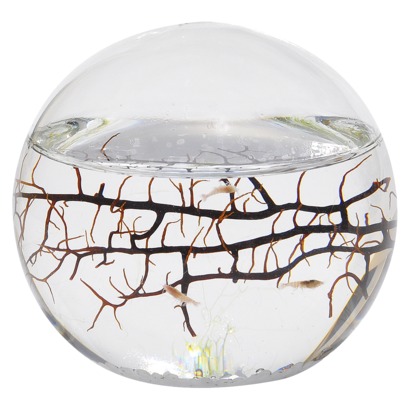
marine shrimp ecosphere
The Basic Theory: In a closed system, like the one in your bottle, you will need to establish an ecological balance in order for all of your organisms to survive and reproduce. The selection of which organisms to use, and how many to begin with, is important, because, for example, if you have too many animals consuming oxygen and not enough plants producing it, the animals will die. If you have too many plants and not enough animals that eat them, the plants may become overcrowded and die. Plants take carbon dioxide (CO2) out of the air and, by a process called photosynthesis, use the energy from sunlight to take those carbons and string them together to make sugars (plant food), releasing the oxygen (O2) as a waste product. Animals use oxygen as part of the process of metabolism (releasing energy from food). Plants and animals are therefore mutualistic; in the right balance, they help each other survive because they each produce what the other needs, and they each use up what the other doesn't need. (Now it's actually a bit more complicated, because plants only produce oxygen when they have light, and they consume oxygen in the dark.) Plants also absorb chemical nutrients like nitrogen (proteins are mostly made of nitrogen and carbon, so dead animals enrich the soil for the plants), phosphorus, and potassium from the soil through their roots. Animals consume the plants (or other animals) and produce wastes that bacteria break down into the nutrients the plants can reuse. Water is consumed by both plants and animals, but is also excreted, purified, and reused. When plants and animals die, they are broken down by decomposer organisms like bacteria and fungi, and the chemicals that were part of their bodies are recycled back into new living things. The only inputs from outside are heat and light, and the whole system should be able to recycle everything else and be self-sustaining across many generations. The earth is a self-sustaining ecosystem that has lasted for billions of years.
This is a project I'd like you to start at the beginning of the semester, so that you can make weekly observations throughout the semester. But there's a catch: Once you seal it up, you can't mess with it anymore. The only allowed inputs to the system are heat and light. To get started, read on...
There's a lot to cover here. Let's start with materials. You will need three or four 2-liter soda bottles. Possibly more if you make mistakes :-) I'd like you to build something similar to the "TerrAqua" column at the Bottle Biology site, or the Building an Eco-Column PDF, but you're going to completely seal it up. No air holes or other inputs except light and heat. You can use either non-toxic silicone sealant (smells like vinegar while drying, takes about 24 hours to fully cure) or duct tape to seal your bottles. We're trying to create a self-sustaining ecosystem that will last a while. Getting things in balance is very tricky, but it can be done.
First steps: Draw your design on paper. Make a detailed plan of what you will need. Assemble your materials. Draw dotted lines where you will cut your bottles. Set it up empty first to make sure it all fits together tightly. Use a few small pieces of tape to temporarily hold it together. Refer to the notes at the resource sites. They have lots of good tips on removing labels, cutting bottles safely, making it fit together, etc. For example, consider whether you will cut above the curve, at the curve, or below the curve of the bottle's top and bottom. If one section curves in, it's easier to fit another section to it. To fit a bottle top into a bottle middle, angle it slightly as you push it in to break the suction/pressure. I made my first cuts with a box cutter, and then trimmed the edges with scissors to make it smoother. It's good to seal as many of the joints between the sections as possible with silicone and let them dry and outgas before you load any living things into the system.
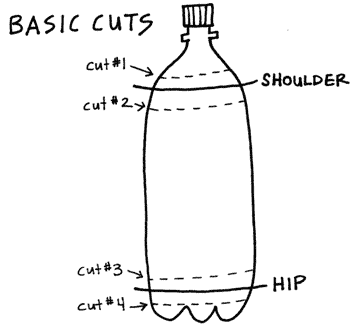
Fit bottles together by cutting one at its widest point and joining it with another where it curves in.
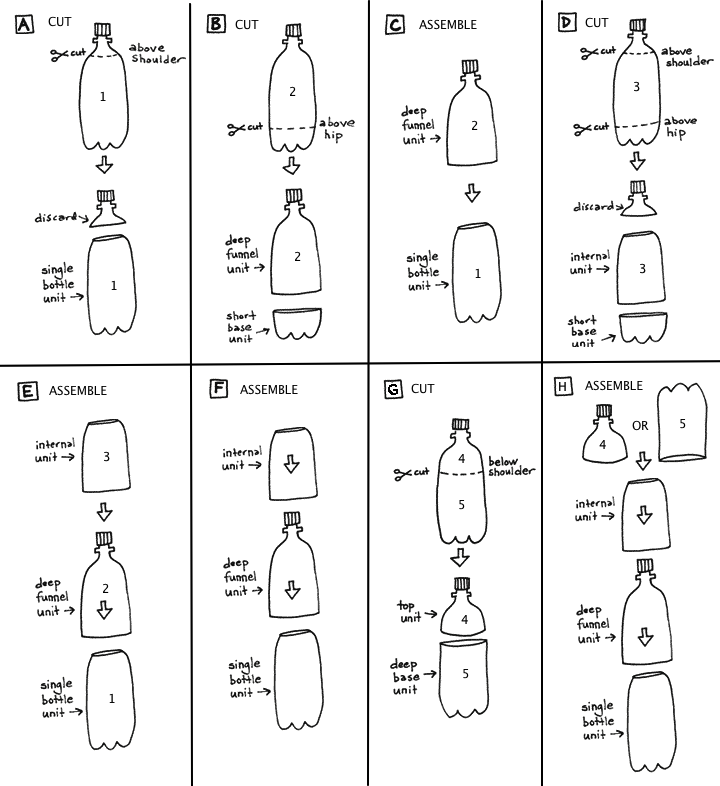
Bottle Assembly Steps: Dry fit the pieces together before adding water, soil, plants, animals.
There are many ways to build your biosphere. The steps above, lettered A-H, using bottles numbered 1-4, will give you the basic idea, but you can expand upon, or deviate from, this design if you want. Step A is the cut for bottle 1, the bottom section, which will contain the aquatic organisms. Step B is the cut for bottle 2, which will form the roof of the aquatic habitat and the connection to the upper chamber. Step C is an assembly step that joins bottle 1 to bottle 2. Step D is the cut of bottle 3, for the walls of the land section. Steps E and F are assembly steps to join bottle 3 to bottles 1 and 2. Step G is the cut of the 4th bottle, which will form the roof of the upper chamber. If you have more bottles, you could keep building upward. The bottle shown in the photographs below has 3 chambers, including one aquatic section and two different land chambers. Note that there should be an opening between all sections so that air and moisture can move throughout the entire bottle complex. However, keeping the cap on top of the aquatic section temporarily while you load the soil, land plants, earthworms, etc., will prevent you from spilling things into the lower section. Just be sure to remove the cap over the aquatic section when you're done with the land habitat. Step H is the completed, 2 chamber bottle biosphere.
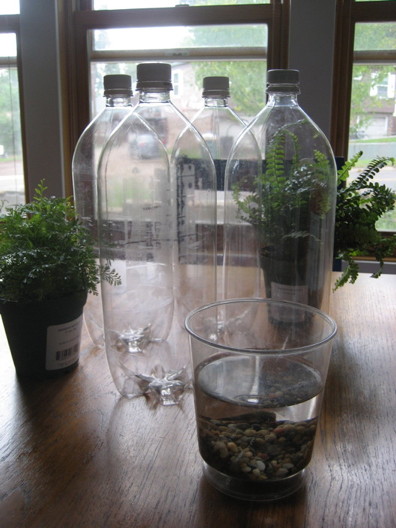
Materials gathered. Plants and animals collected. Ready to start cutting bottles.
Collect your living things. Note: Use pond water or freshwater aquarium water. Tap water won't have the right bacteria in it. You can use fine aquarium gravel, sand, and/or potting soil. An aquarium store or local pond will have some aquatic plants. Potting soil is tricky because it will absorb a lot of moisture at first and can be messy to work with. The more complex your biosphere, the more interesting it can be, but remember not to overload it with animals. Don't put fish, frogs, reptiles, etc. in your biosphere; they won't survive long because it's too small and can't support them. A little bit of pond mud will contain some good microscopic invertebrates. Try a few small snails, maybe a few small earthworms, some daphnia or other freshwater invertebrates collected from a pond or stream with a dip net. Make it more like a terrarium. Try some hardy plants; preferably more than one kind. Leave the components open to the air for a week or two while you adjust the moisture levels and get everything established.
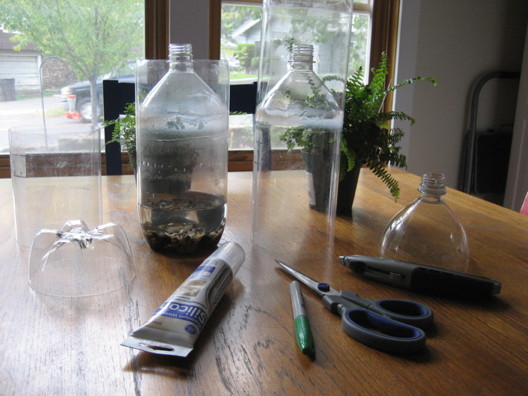
Aquatic section partially loaded. Sealing empty sections with silicone.
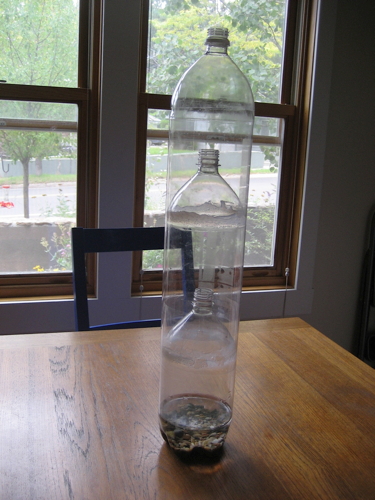
Empty partially sealed sections pieced together to check fit.
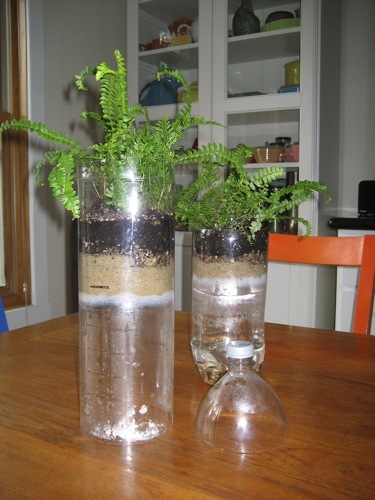
Plants loaded into terrestrial sections; adjusting moisture levels before final seal up.
It's easy to accidentally oversaturate the soil with water, and that will cause problems later. I added some sand and coarse aquarium gravel for drainage at the bottom of my terrestrial sections, and very gradually added water, watching the water level on the outside. Leaving it open for a week or two before sealing it up will allow excess water to evaporate. You want the soil damp but not soggy. I also added 2 small earthworms I collected after a rainstorm to the soil. Hope they make it!
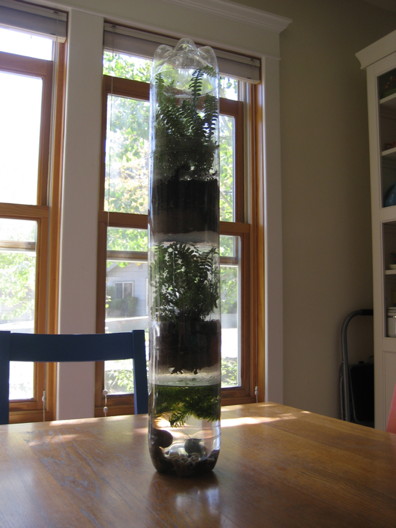
The bottle biosphere is now air-tight. With luck, we've got a self-sustaining eco-system inside.
When the moisture levels are right and everything is loaded inside, seal it up for good and hope for the best. You can still adjust the position of your biosphere relative to heat and light. If too much algae grows, it's too bright. If the plants start to yellow or brown, try a brighter spot. Make sure it doesn't heat up too much or get too cold. Think about the inside of your car on a hot day. Even if things start to crash, keep making observations. Molds are living things too. Think about the cycles that are happening inside the bottle as it warms and cools during day and night, light and dark cycles, and as water, oxygen and carbon dioxide, carbon, nitrogen and other nutrients cycle through the system. Read up on all of the following, because they will help you to understand what's happening inside your "closed system."
Make weekly notes, take weekly photos*, and upload to your personal "Journal." It may not seem like much is happening day to day, but comparing photos week to week may reveal bigger changes. There's a lot going on inside your little biosphere.
*Photo request: Your photos don't have to be at the full resolution of your fancy smartphone or high megapixel camera. Scale 'em down if you can, so that they aren't gigantic. Since I'm being picky here, in focus is nice too! The graphics above are scaled down to about 100 kilobytes each and still look pretty good. Use the "optimize for e-mail" option if available.
2 Liter Bottle Bottles Drawing
Source: https://www2.nau.edu/lrm22/lessons/bottle_biology/
Komentar
Posting Komentar